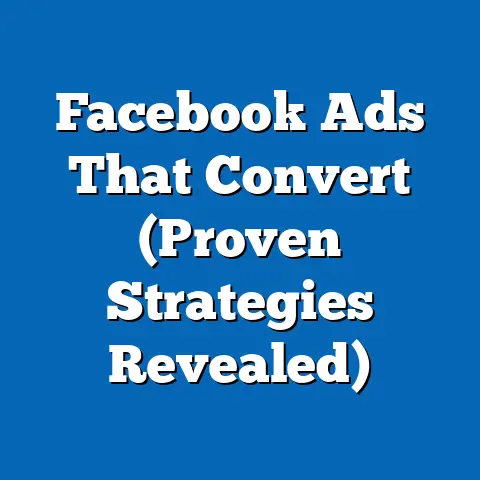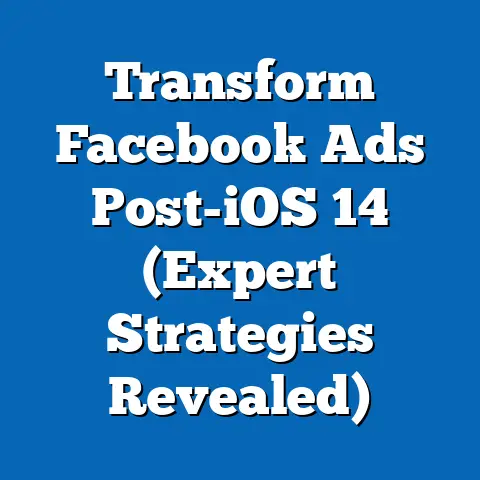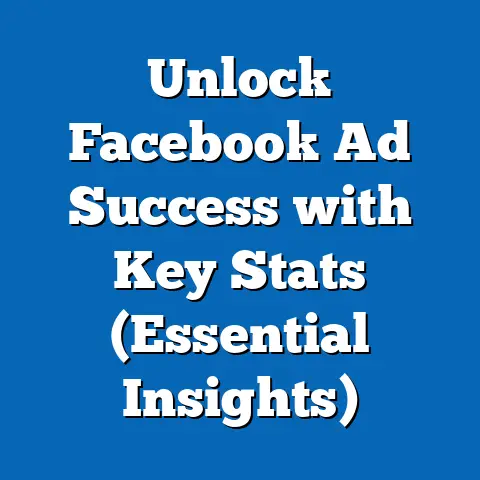Revamp Facebook Ads with Stunning Image Updates (Pro Tips)
The air is crisp, pumpkin spice lattes are back, and leaves are turning into a breathtaking tapestry of red, orange, and gold. Fall is here, and with it comes a golden opportunity to revamp your Facebook ads with stunning image updates! As a digital marketing specialist with years of experience navigating the ever-changing landscape of social media advertising, I can tell you firsthand: nothing breathes fresh life into a campaign quite like a visual refresh.
Think about it – we’re bombarded with ads every single day. To cut through the noise, your visuals need to be not just good, but great. They need to grab attention, evoke emotion, and, most importantly, compel viewers to take action. With the holiday season looming – Halloween, Thanksgiving, Black Friday, Cyber Monday – now is the perfect time to dust off those old creatives and inject some seasonal flair into your Facebook ad strategy.
1: The Importance of Visuals in Facebook Advertising
Visuals aren’t just pretty pictures; they are the cornerstone of effective Facebook advertising. They’re the first thing people notice, and they play a crucial role in shaping their perception of your brand and product. Think of it like this: your ad image is your first impression. You wouldn’t show up to a job interview in your pajamas, would you? Similarly, you can’t expect to grab attention with a blurry, uninspired image.
The Psychology of Visuals: Why They Work
Our brains process visuals 60,000 times faster than text. This isn’t just a fun fact; it’s a fundamental principle that drives consumer behavior online. Visuals trigger emotional responses, create associations, and influence decision-making in ways that words alone simply can’t.
- Emotional Connection: A well-crafted image can evoke feelings of joy, excitement, nostalgia, or even urgency. These emotions can be powerful drivers of purchase decisions. For example, during the holiday season, images of cozy family gatherings or festive decorations can tap into the emotional connection people have with the holidays, making them more receptive to your message. I’ve seen firsthand how a simple image of a crackling fireplace and a steaming mug of cocoa can boost engagement for a winter-themed campaign.
- Storytelling: Visuals can tell a story in an instant. Instead of relying on lengthy descriptions, you can use an image to convey the benefits of your product or service in a relatable and engaging way. Think about Airbnb – their ads often feature stunning photos of unique properties, instantly transporting viewers to a dream vacation destination.
- Brand Recognition: Consistent use of visual elements like colors, fonts, and imagery helps build brand recognition. When people see your ads, they should immediately recognize your brand and associate it with positive experiences. I once worked with a local bakery that struggled to gain traction online. By focusing on high-quality photos of their delicious pastries and using a consistent color palette in their ads, they quickly built a strong brand identity and saw a significant increase in orders.
Statistics to Consider:
- Attention Spans: According to research, the average human attention span is now shorter than that of a goldfish. This means you have mere seconds to capture someone’s attention online.
- Visual Content Performance: Studies show that posts with images get 2.3 times more engagement than those without.
- Purchase Decisions: 90% of information transmitted to the brain is visual, and visuals are processed 60,000X faster in the brain than text.
Facebook’s Algorithm: Visuals Get Priority
Facebook’s algorithm is constantly evolving, but one thing remains consistent: it favors content that users find engaging. And guess what? Visuals are inherently more engaging than text-heavy posts.
- Relevance Score: Facebook uses a “relevance score” to determine how well your ad resonates with your target audience. High-quality visuals can significantly improve your relevance score, leading to lower costs and better ad placement.
- User Behavior: Facebook tracks how users interact with your ads, including likes, comments, shares, and clicks. Ads with engaging visuals are more likely to generate positive interactions, signaling to the algorithm that your content is valuable and deserves to be shown to more people.
- Ad Fatigue: If your ads are visually stale, people will start to tune them out. This can lead to ad fatigue, which results in decreased performance and increased costs. Regularly updating your visuals with fresh, relevant content helps keep your audience engaged and prevents ad fatigue.
Current Trends in Visual Content
Staying on top of the latest trends in visual content is crucial for creating ads that stand out. What works today might not work tomorrow, so it’s important to continuously experiment and adapt your strategy.
- Short-Form Video: Platforms like TikTok and Instagram Reels have popularized short-form video, and Facebook is following suit. Incorporating short, engaging videos into your ads can be a highly effective way to capture attention and convey your message. I’ve seen businesses use short videos demonstrating their product in action, or even just showing behind-the-scenes glimpses of their operations, with great success.
- User-Generated Content (UGC): Featuring authentic user-generated content in your ads can build trust and credibility. People are more likely to believe recommendations from other customers than marketing messages from brands.
- Interactive Content: Interactive elements like polls, quizzes, and AR filters can make your ads more engaging and encourage users to interact with your brand.
- Augmented Reality (AR): AR filters allow users to virtually try on products or experience your brand in a unique way. This is particularly effective for industries like fashion, beauty, and home decor.
Key Takeaway: Visuals are the lifeblood of successful Facebook advertising. By understanding the psychology of visuals, leveraging Facebook’s algorithm, and staying on top of current trends, you can create ads that capture attention, drive engagement, and ultimately, achieve your business goals.
Next Steps: Start brainstorming ideas for visually appealing ads that align with the current season and your brand message.
2: Analyzing Your Current Image Strategy
Before you start creating new images, it’s essential to take a hard look at your current Facebook ad image strategy. What’s working? What’s not? Are your images truly resonating with your target audience?
Evaluating Performance Metrics
The first step in analyzing your image strategy is to dive into your Facebook Ads Manager and review your performance metrics. Here are some key metrics to pay attention to:
- Click-Through Rate (CTR): This metric measures the percentage of people who saw your ad and clicked on it. A low CTR indicates that your image isn’t compelling enough to grab attention.
- Engagement Rate: This metric measures the percentage of people who interacted with your ad, including likes, comments, shares, and saves. A low engagement rate suggests that your image isn’t resonating with your target audience.
- Conversion Rate: This metric measures the percentage of people who took a desired action after clicking on your ad, such as making a purchase or filling out a form. A low conversion rate could indicate that your image isn’t effectively communicating the value of your product or service.
- Cost Per Click (CPC): This metric measures the average cost you pay each time someone clicks on your ad. A high CPC could indicate that your ad isn’t relevant to your target audience, or that your image isn’t compelling enough to justify the cost.
- Return on Ad Spend (ROAS): This metric measures the revenue you generate for every dollar you spend on advertising. A low ROAS indicates that your ad campaign isn’t profitable.
Pro Tip: Don’t just look at the overall performance of your campaigns. Break down your results by individual ad sets and ads to identify which images are performing best.
Common Pitfalls in Image Selection
Even experienced advertisers can fall into common traps when selecting images for their Facebook ads. Here are some pitfalls to avoid:
- Low-Quality Images: Blurry, pixelated, or poorly lit images will immediately turn people off. Always use high-resolution images that are professionally shot or edited. I’ve seen campaigns completely tank because the images looked like they were taken with a potato.
- Overused Stock Photos: Generic stock photos can make your ads look bland and unoriginal. Try to use unique, authentic images that showcase your brand’s personality.
- Irrelevant Images: Your image should be directly relevant to your product, service, and target audience. Don’t use images that are simply eye-catching but don’t communicate the value of your offer.
- Inconsistent Branding: Your image should be consistent with your overall brand aesthetic. Use the same colors, fonts, and imagery that you use on your website and other marketing materials.
- Ignoring Seasonal Trends: Using the same images year-round can make your ads look stale and out of touch. Update your visuals to reflect the current season and holidays.
Gathering Audience Feedback
While data analysis is crucial, it’s also important to get direct feedback from your target audience. Here are some ways to gather audience feedback on your current ad images:
- Facebook Polls: Create a poll on your Facebook page and ask your followers to vote on their favorite ad images.
- Surveys: Use online survey tools like SurveyMonkey or Google Forms to gather more detailed feedback on your ad images.
- Focus Groups: Conduct focus groups with members of your target audience to get in-depth feedback on your ad images.
- A/B Testing: As we’ll discuss later, A/B testing is a powerful way to compare the performance of different ad images and see which ones resonate best with your audience.
Key Takeaway: Analyzing your current image strategy is crucial for identifying areas for improvement. By evaluating performance metrics, avoiding common pitfalls, and gathering audience feedback, you can gain valuable insights that will inform your future ad campaigns.
Next Steps: Review your Facebook Ads Manager and analyze the performance of your current ad images. Identify any areas where you can improve your visual strategy.
3: Crafting Stunning Seasonal Images
Now that you’ve analyzed your current image strategy, it’s time to start crafting stunning seasonal images that will captivate your audience and drive results. Here are some key elements to consider:
Composition
Composition refers to the arrangement of elements within your image. A well-composed image is visually balanced, draws the eye to the focal point, and tells a story.
- Rule of Thirds: This is a classic composition technique that involves dividing your image into nine equal parts with two horizontal and two vertical lines. Place key elements along these lines or at the points where they intersect to create a more visually appealing image.
- Leading Lines: Use lines within your image to guide the viewer’s eye towards the focal point. This can be anything from a road to a fence to a row of trees.
- Symmetry: Symmetrical compositions can create a sense of balance and harmony. This can be particularly effective for showcasing products or creating a sense of elegance.
- Negative Space: Using negative space (the empty space around your subject) can help draw attention to the focal point and create a sense of calm and simplicity.
Color Schemes
Color plays a crucial role in evoking emotions and creating associations. Choose color schemes that are appropriate for the season and your brand.
- Fall: Warm, earthy tones like red, orange, yellow, and brown evoke feelings of warmth, comfort, and nostalgia.
- Winter: Cool, crisp tones like blue, white, and silver evoke feelings of peace, tranquility, and winter wonderland.
- Spring: Bright, vibrant tones like green, pink, yellow, and purple evoke feelings of freshness, renewal, and optimism.
- Summer: Warm, sunny tones like yellow, orange, red, and blue evoke feelings of energy, excitement, and adventure.
Pro Tip: Use color psychology to your advantage. Research the emotions and associations that different colors evoke, and choose colors that align with your brand message and the desired emotional response.
Relevance to the Season
Your images should be clearly relevant to the current season. This means incorporating seasonal motifs, symbols, and themes into your visuals.
- Fall: Use images of leaves, pumpkins, corn stalks, and other fall-related items. Feature cozy clothing, warm drinks, and autumnal landscapes.
- Winter: Use images of snowflakes, snow-covered landscapes, Christmas trees, and holiday decorations. Feature warm clothing, festive treats, and winter activities.
- Spring: Use images of flowers, blooming trees, and green meadows. Feature light clothing, outdoor activities, and springtime holidays like Easter.
- Summer: Use images of beaches, sunshine, and blue skies. Feature swimwear, outdoor activities, and summer holidays like the Fourth of July.
Pro Tips for Capturing Resonant Images
- Lighting: Pay attention to the lighting in your images. Natural light is generally the most flattering, but you can also use artificial lighting to create different moods and effects.
- Mood: Think about the mood you want to create with your images. Do you want to evoke feelings of joy, excitement, nostalgia, or peace?
- Thematic Elements: Use thematic elements to reinforce the seasonal message of your images. This could include anything from seasonal props to themed backgrounds to holiday-related decorations.
- Authenticity: Strive for authenticity in your images. Avoid overly staged or posed photos. Capture candid moments that feel real and relatable.
Key Takeaway: Crafting stunning seasonal images requires careful attention to composition, color schemes, and relevance to the season. By following these tips, you can create visuals that capture attention, evoke emotion, and drive results.
Next Steps: Start brainstorming ideas for seasonal images that align with your brand message and target audience.
4: Utilizing Graphic Design Tools for Image Revamp
You don’t need to be a professional graphic designer to create stunning visuals for your Facebook ads. There are a variety of user-friendly graphic design tools that can help you create professional-looking images, even if you have limited design experience.
Popular Graphic Design Tools
- Canva: Canva is a popular online graphic design tool that offers a wide range of templates, images, and design elements. It’s incredibly easy to use, even for beginners, and it’s a great option for creating social media graphics, presentations, and marketing materials. I’ve used Canva for years and I find it to be an invaluable tool for creating quick and effective visuals.
- Adobe Spark: Adobe Spark is another user-friendly graphic design tool that offers a variety of templates, images, and design elements. It’s particularly well-suited for creating short videos and animated graphics.
- PicMonkey: PicMonkey is a photo editing and graphic design tool that offers a wide range of features, including photo retouching, filters, and text overlays.
- GIMP: GIMP (GNU Image Manipulation Program) is a free and open-source image editor that offers a wide range of features, similar to Adobe Photoshop. It’s a great option for more advanced users who want more control over their image editing.
- Adobe Photoshop: Adobe Photoshop is the industry-standard image editing software. It offers a wide range of features and capabilities, but it can be more complex to learn than other tools.
Step-by-Step Guidance
Here’s a step-by-step guide on how to use Canva to create stunning seasonal ads:
- Sign Up for a Canva Account: If you don’t already have one, sign up for a free Canva account.
- Choose a Template: Canva offers a wide range of templates for Facebook ads. Choose a template that aligns with your brand message and the desired aesthetic.
- Customize the Template: Customize the template by changing the colors, fonts, images, and text.
- Add Seasonal Elements: Add seasonal elements to your design, such as leaves, snowflakes, flowers, or holiday decorations.
- Upload Your Own Images: If you have your own images, upload them to Canva and incorporate them into your design.
- Download Your Design: Once you’re happy with your design, download it in the appropriate format for Facebook ads (e.g., JPG or PNG).
Maintaining Brand Consistency
While it’s important to incorporate seasonal elements into your ads, it’s also crucial to maintain brand consistency. This means using the same colors, fonts, and imagery that you use on your website and other marketing materials.
- Brand Kit: Canva offers a “brand kit” feature that allows you to store your brand colors, fonts, and logos in one place. This makes it easy to maintain consistency across all of your designs.
- Templates: Create custom templates that incorporate your brand elements and seasonal themes. This will save you time and ensure that your ads are always on-brand.
- Guidelines: Develop clear brand guidelines that outline the dos and don’ts of using your brand elements in your ads.
Key Takeaway: Graphic design tools like Canva make it easy to create stunning visuals for your Facebook ads, even if you have limited design experience. By following these tips, you can create professional-looking ads that are both visually appealing and on-brand.
Next Steps: Experiment with different graphic design tools and find one that you’re comfortable using. Start creating seasonal ads that align with your brand message.
5: A/B Testing Your Image Choices
You’ve created some stunning seasonal images, but how do you know which ones will perform best? The answer is A/B testing.
What is A/B Testing?
A/B testing, also known as split testing, is a method of comparing two versions of an ad to see which one performs better. In the context of Facebook ads, you can use A/B testing to compare different images, headlines, ad copy, and call-to-action buttons.
Why A/B Testing is Crucial
A/B testing is crucial for optimizing your Facebook ad campaigns because it allows you to make data-driven decisions about your visual strategy. Instead of relying on guesswork or intuition, you can use A/B testing to identify the images that resonate best with your target audience and drive the best results.
- Improved Performance: A/B testing can help you identify the images that generate the highest click-through rates, engagement rates, and conversion rates.
- Reduced Costs: By optimizing your visual strategy, you can reduce your cost per click and improve your return on ad spend.
- Better Targeting: A/B testing can help you understand which images resonate best with different segments of your target audience.
- Continuous Improvement: A/B testing is an ongoing process that allows you to continuously improve your visual strategy and stay ahead of the curve.
Setting Up A/B Tests
Here’s how to set up A/B tests for your Facebook ad images:
- Create Two Versions of Your Ad: Create two versions of your ad that are identical except for the image.
- Define Your Hypothesis: Before you start your A/B test, define your hypothesis. What do you expect to happen? For example, you might hypothesize that an image with a brighter color scheme will perform better than an image with a darker color scheme.
- Set Up Your A/B Test in Facebook Ads Manager: Facebook Ads Manager makes it easy to set up A/B tests. Simply create a new campaign and choose the “A/B Test” objective.
- Choose Your Metrics: Choose the metrics you want to track, such as click-through rate, engagement rate, and conversion rate.
- Set Your Budget and Schedule: Set your budget and schedule for your A/B test. It’s important to run your A/B test for a sufficient amount of time to gather enough data to make a statistically significant conclusion.
- Analyze Your Results: Once your A/B test is complete, analyze the results to see which image performed better.
Tips for Effective A/B Testing
- Test One Element at a Time: To get accurate results, it’s important to test only one element at a time. For example, if you’re testing different images, keep the headline, ad copy, and call-to-action button the same.
- Use a Large Sample Size: The larger your sample size, the more statistically significant your results will be.
- Run Your A/B Test for a Sufficient Amount of Time: Run your A/B test for a sufficient amount of time to gather enough data to make a statistically significant conclusion.
- Don’t Stop Testing: A/B testing is an ongoing process. Continuously test different images and elements to optimize your visual strategy.
Key Takeaway: A/B testing is a powerful tool for optimizing your Facebook ad images. By setting up A/B tests and analyzing the results, you can identify the images that resonate best with your target audience and drive the best results.
Next Steps: Set up A/B tests for your Facebook ad images and start gathering data to optimize your visual strategy.
6: Case Studies of Brands That Revamped Their Facebook Ads
Let’s take a look at some real-world examples of brands that successfully revamped their Facebook ads with new images during a specific season.
Case Study 1: Starbucks (Fall Campaign)
- Strategy: Starbucks is known for its seasonal campaigns, and their Fall campaign is no exception. They revamped their Facebook ads with images of pumpkin spice lattes, cozy coffee shops, and autumnal landscapes.
- Challenges: Starbucks faced the challenge of standing out in a crowded market. Many coffee shops offer pumpkin spice lattes during the Fall season, so Starbucks needed to find a way to differentiate themselves.
- Results: Starbucks’ Fall campaign was a huge success. Their Facebook ads generated high click-through rates, engagement rates, and conversion rates. They were able to effectively tap into the emotional connection people have with Fall and drive sales of their pumpkin spice lattes.
- Key Takeaway: Starbucks successfully revamped their Facebook ads by incorporating seasonal motifs, creating a cozy and inviting atmosphere, and focusing on their signature pumpkin spice latte.
Case Study 2: L.L.Bean (Winter Campaign)
- Strategy: L.L.Bean revamped their Facebook ads with images of snow-covered landscapes, cozy winter clothing, and outdoor activities.
- Challenges: L.L.Bean faced the challenge of convincing people to purchase their winter clothing and gear. Many people associate winter with cold and discomfort, so L.L.Bean needed to find a way to make winter seem appealing.
- Results: L.L.Bean’s Winter campaign was a success. Their Facebook ads generated high click-through rates, engagement rates, and conversion rates. They were able to effectively showcase the benefits of their winter clothing and gear and inspire people to embrace the season.
- Key Takeaway: L.L.Bean successfully revamped their Facebook ads by showcasing the beauty of winter, highlighting the benefits of their products, and inspiring people to embrace outdoor activities.
Case Study 3: Target (Summer Campaign)
- Strategy: Target revamped their Facebook ads with images of beaches, sunshine, and blue skies. They featured swimwear, outdoor toys, and summer essentials.
- Challenges: Target faced the challenge of standing out in a competitive market. Many retailers offer summer products, so Target needed to find a way to differentiate themselves.
- Results: Target’s Summer campaign was a success. Their Facebook ads generated high click-through rates, engagement rates, and conversion rates. They were able to effectively capture the spirit of summer and inspire people to shop for their summer essentials at Target.
- Key Takeaway: Target successfully revamped their Facebook ads by showcasing the fun and excitement of summer, highlighting their wide selection of products, and creating a sense of urgency.
Key Takeaway: These case studies demonstrate the power of revamping your Facebook ads with new images that are relevant to the current season. By incorporating seasonal motifs, creating a compelling atmosphere, and highlighting the benefits of your products, you can capture attention, drive engagement, and achieve your business goals.
Next Steps: Analyze these case studies and identify the key strategies that you can apply to your own Facebook ad campaigns.
Conclusion: The Future of Visuals in Facebook Ads
We’ve covered a lot of ground in this guide, from the psychology of visuals to the practical steps of crafting stunning seasonal images. The key takeaways are clear: visuals are essential for successful Facebook advertising, and regularly updating your visuals with fresh, relevant content is crucial for staying ahead of the curve.
The Importance of Seasonal Imagery
Seasonal imagery is particularly important because it allows you to tap into the emotional connection people have with different times of the year. By incorporating seasonal motifs, colors, and themes into your ads, you can create visuals that are both visually appealing and emotionally resonant.
Future Trends in Visual Content
The future of visual content is constantly evolving. Here are some trends to watch out for:
- Augmented Reality (AR): AR filters and experiences are becoming increasingly popular on social media. This technology allows users to virtually try on products, explore new environments, and interact with brands in unique ways.
- Artificial Intelligence (AI): AI is being used to generate personalized visual content for social media. This technology can analyze user data and create images that are tailored to individual preferences.
- Interactive Content: Interactive elements like polls, quizzes, and games are becoming increasingly popular in social media advertising. These elements can make your ads more engaging and encourage users to interact with your brand.
- 3D and Immersive Experiences: 3D and immersive experiences are becoming more accessible on social media. This technology allows users to explore virtual environments and interact with products in a more realistic way.
Staying Ahead of the Curve
To stay ahead of the curve in the ever-changing world of Facebook advertising, it’s important to continuously experiment with new visual strategies and technologies. Don’t be afraid to try new things, and always be willing to adapt your approach based on the results you see.
Remember, the most successful Facebook advertisers are those who are willing to embrace change and continuously evolve their visual strategies. By following the tips and strategies outlined in this guide, you can revamp your Facebook ads with stunning image updates and achieve your business goals.
Final Thoughts:
As I always tell my clients, the world of Facebook advertising is a marathon, not a sprint. Stay persistent, stay creative, and never stop learning. The stunning visuals you create today could be the key to unlocking your next big success story!






